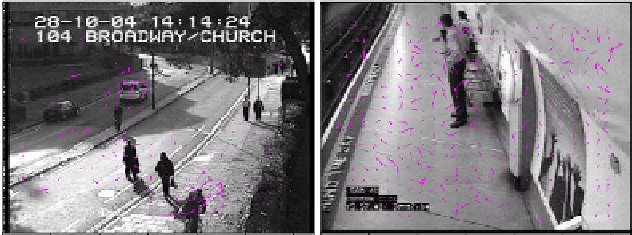Information Technology Reference
In-Depth Information
serves as the confidence measure for our static human appearance hypothesis. This
approach has achieved very good detection rate in static images of outdoor scene
[3], e.g. image samples from the MIT pedestrian dataset [17]. However, the lack
of motion information makes this detector less robust to background clutters. This
problem becomes severe in cluttered scenes with poor lighting, such as in public un-
derground, when such a static human detector gives unacceptable false alarm rate,
as shown by examples in Figs 8 and 9. Simply increasing the threshold of the score
for generating the hypothesis does not result in reducing the false alarms because in
such cluttered scenes, regions in background have very similar appearance to that of
people, e.g. as shown in Fig. 8 (e). Here the false alarms on the wall have very high
scores produced by the classifier and do indeed look like standing people. Similar
observations can be found in the example shown in Fig. 9 (b). Given that in any
public scene, people exhibit inevitably long-term-moving patterns instead of just a
static pattern, we consider a detection model based on fusing detected static human
presence hypothesis with their long-term motion history information as follows.
2.2
Motion Confidence
One way to utilize motion information is to compute optic flow [10, 18, 5]. However,
optic flow estimation makes a strong assumption that motions are only caused by ei-
ther relative movement between the camera and the object of interest or ego-motion.
The accuracy of flow estimation is based on well sampled data, i.e. local smooth-
ness. However, both assumptions are not usually satisfied in real applications. First,
large lighting changes usually result in noisy flow field. Second, relatively fast ac-
tion w.r.t the camera, i.e. low frame rate, also results in highly discontinuous motion
which is far from smooth. Examples of estimating optic flow in a underground scene
are shown in Fig. 2. The optic flow was computed using a robust method proposed
by Gautama et al. [5]. However, it is evident that the resulting flow field is very
(a)
(b)
Fig. 2
Optic flow estimation comparison in different sequences. (a) regular flow on well-
captured outdoor sequence; (b) noisy flow on a real underground sequence. Note that in (b),
the upper-right corner has some distinct noisy optic flow caused by lighting changes and
object reflections.








Search WWH ::

Custom Search